Jack McCall was born in 1911 in his grandfather’s house east of Eureka Springs. His grandfather was George McCall, a widower and Justice of the Peace for the Kings River Township.
Justices of the Peace in those days had expanded powers. For instance, Jack remembered his grandfather holding court in the parlor. Two fellows might be brought in for fighting and disturbing the peace, and George McCall would ascertain the facts of the altercation and levy a fine as he deemed necessary.
The historic house has been gone for several years now, but what brought it to mind was a book I happened across at the Eureka Springs Carnegie Library titled Ozark Vernacular Houses: A Study of Rural Homeplaces in the Arkansas Ozarks 1830-1930 by Jean Sizemore. It turns out that the McCall house was a particular type of Ozark house called a “Central Hall Cottage.”
I know very little about architecture, but I fell in love with the McCall house at a young age. It’s interesting how some houses have character and personality, while others do not make an impression. The front of the white frame house had a portico in the center with square wooden columns. The screen door behind lead into the Central Hall or “breezeway.” The front was in perfect balance, each side a mirror of the other. Equal distance from the portico, on either side, were tall narrow windows, and equal distance from the windows were handsome limestone chimneys.
I’m told that the house began as a one room cabin when the family returned to Arkansas following the Civil War and then evolved as the size of the family fluctuated from generation to generation. At one time, the kitchen was outside in a separate building, so that the cooking could be done away from the house, especially in the oppressive heat of summer. I remember the antique window panes were thick and flawed and that the scent of nearly a dozen decades of wood fires greeted visitors. Though the house is gone forever it does continue to live in a small way as the home of Max McCaver in my novel Murder in the Ozarks.

